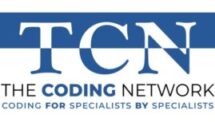Interventional Radiology Coding
Interventional radiology coding, including neuro-interventional coding and endovascular surgery coding, can be the most challenging clinical subspecialty to code. We know because we code them all.
Advances in technology means that more procedures will be performed; the ACR expects an 8% annual growth in interventional radiology and other high-tech services. The consequences of this growth will include an exacerbation of the current shortage of skilled interventional radiology coders. It also means that the interventional radiology coding rules, regulations, and edits will continue to change, and keeping up with the dual evolution of the science and the coding will be an ever-more-difficult day-to-day struggle for interventional radiology coders.
At many hospitals, the shorage of talented interventional radiology coding means that the interventional radiology coding is frequently done by diagnostic radiology coders or the interventionalist or a radiology technician. The diagnostic radiology coders don’t understand interventional radiology. Radiologist diagnose diseases and medical conditions while interventionalists treat them. Interventionalists perform a broad spectrum of intricate treatments throughout the anatomy; ablations, chemo-embolization, thrombolysis, balloon occlusions, kyphoplasty, dilating and stenting distant arteries, placement of vascular filters, plus many more gynecologic, GI, and neurosurgical procedures. Diagnostic radiology coders are rarely familiar with these interventional procedures or the interventional radiology-specific coding rules and edits. Diagnostic radiology reports are generally very brief, and the coders’ main challenge is to find a code-able diagnostic statement, but IR reports are often long and intimidating. As a result, the responsibility for coding frequently defaults back to the providers.
Any time that an interventionalist spends coding is time forever lost from revenue-generating patient care that only they can do. Having an interventional radiologist code operations is perhaps the ultimate misuse of time — he/she will be one of the highest paid coders on the planet. Technicians, while they might well understand the intracies of the procedures, often have little knowledge of the complex set of rules, regulations, and edits that govern interventional radiology coding, billing, and reimbursement. They often check-off a pre-printed (and frequently obsolete) charge sheet on the basis of what the interventionalist called the procedure, rather than what services are actually documented in the procedure report. This can inadvertently create enormous compliance risk in the event of an OIG or RAC audit, or huge amounts of lost revenue if the report documents additional separately billable-but-omitted procedures. Placing a check mark on a charge sheet is a far cry from the arcane precision required for accurate interventional radiology coding, and there can be material compliance exposure for all of the radiologists and the hospital if the codes aren’t supported by the details of the narrative in the report. .
Compare this to The Coding Network. We have a separate Division of our company that only does interventional radiology coding, neuro-interventional radiology coding, endovascular surgery coding, and peripheral vascular surgery coding. Each of these coders is a dual certified, proficiency tested and a regularly Q/A’d IR “black belt” with years of interventional radiology experience. They only code for interventionalists, so their skills are current and highly refined. They all live-and-work in the United States of America, so none of your reports (or patients’ protected heatlh information) is sent to third-world countries.
The Coding Network’s Interventional Radiology Coding Division:
- Directed by a nationally recognized interventional coding expert who is a published author and has delivered coding presentations to multiple annual meetings of the Society of Intervenional Radiology and other national and regional associations.
- Decades of experience in interventional radiology coding.
- A team of interventional radiology coders, each focusing on just this subspecialty.
- Experience in coding for clients in 49 states, and at tertiary academic medical centers as well as private practices and community hospitals.
Interventional Radiology Coding Need:
- Skilled interventional radiology coders are scarce and difficult to find. They are expensive to recruit and hire, and their ongoing “care and feeding” can be quite costly.
- Few certified coders have the interventional radiology coding experience, training, and management resources possessed by The Coding Network’s Division of Interventional Radiology Coding.
- Interventional radiology coding , particularly neuro-angio procedures, is among the most complex and challenging coding ever. It presents a unique set of challenges with different families and levels of vessels, transcatheter and endovascular procedures, and intraoperative radiography.
- Coder turnover is frequent due to the acute shortage of interventional radiology coders. Turnover can create cash flow “whiplash,” backlogs, and lost revenue among its other disruptive consequences.
- It takes a huge interventional radiology practice to cost-justify the hiring of a dedicated interventional radiology coder. Most practices, even those in tertiary medical centers, do not have the volume of cases to support an interventional radiology coder.
- There is no such thing as a “mulligan” when it comes to interventional radiology coding. Medicare and insurance claims must be accurate the first time or your compliance risk grows and possibility of never-to-be recovered revenue mounts-up.
The Coding Network’s Interventional Radiology Coding Solution:
- The Coding Network’s interventional radiology coders are world-class experts in each individual subspecialty within the entire spectrum of interventional radiology, including:
- Neurointerventional Radiology Coding
- Interventional Radiology Coding
- Endovascular Surgery Coding
- Peripheral Vascular Surgery Coding
- Angiointerventional Radiology Coding
- Gynecologic Interventional Radiology Coding
- Nephrointerventional Radiology Coding
- 2-to-3 business day turnaround using HIPAA + HITECH compliant secure email, overnight courier, or fax. We can remotely and securely dial-into your electronic medical record, RIS, or transcription archives.
- None of your documents — or your patients’ protected health information — will be sent offshore to third-world countries.
- Our per-case pricing structure turns your fixed salary overhead into a much preferred variable expense. You only pay for what you need.
- Never worry abour vacation coverage, absences, family leaves, etc. Revenue cycle peaks-and-valleys are reduced.
- No monthly minimums gives you total control; you can stop sending us cases to code at any time. This “keeps us on our toes.”
- Our volume driven pricing makes us an ideal ongoing solution for practices of all sizes.
- Identification and feedback of document deficiencies is included at no additional cost. This will help improve the quality of your medical records.
- All of our interventional radiology coders keep up-to-date with the continuous changes in the coding rules, regulations, and edits. This reduces costly denials and rebilling and minimizes your compliance exposure.
The Coding Network’s Services:
- Ongoing day-to-day interventional radiology coding.
- Temporary interventional radiology coding to cover medical leave, family leave, vacancies during turnover-and-recruitment.
- Interventional radiology coding backlog resolution.
- Peer review auditing the accuracy of your own interventional radiology coding with user-friendly educational report formats to identify both compliance risks and missed revenue opportunities.
- Medical records documentation training with interventional radiology specific workbooks.
- Interventional radiology coding helpline services.
- RAC and OIG audit defense.

Latest Blog Posts:
Why Human Oversight in AI Medical Coding Remains Essential in 2025
The emergence of AI in medical coding is invariably impacting healthcare and traditional workflows and resource allocation. Yet, as AI platforms tout accuracy rates exceeding 90%, a critical question persists: Can autonomous coding stand alone? [...]
AI Medical Coding Is Fast—Until Compliance Slows You Down
Why Human Validation Is Now Mission‑Critical (and How to Add It Overnight) Artificial‑intelligence engines from Aidéo, Fathom, Nym, 3M, and others are transforming medical coding speed. Yet payers haven’t lowered the bar— they’ve raised it. Humana, [...]
How to Dodge the Holiday Coding Backlog – Without Adding Full‑Time Staff
Summer vacations fill the calendar, and Labor Day marks the starting line of a four‑month holiday sprint. For revenue‑cycle leaders, that means one thing: charts start stacking up on Friday, coders walk in Monday to a [...]
Need Professional Medical Coding Assistance: Why Using Your Doctors To Code Is Not Free
In today’s fast-paced healthcare environment, efficiency and accuracy are non-negotiable. Every medical practice, hospital, and healthcare system strives to optimize revenue, ensure compliance, and deliver exceptional patient care. One area that often flies under the [...]




